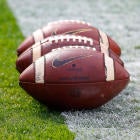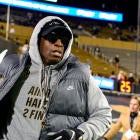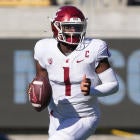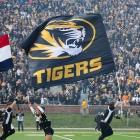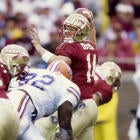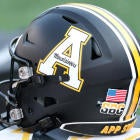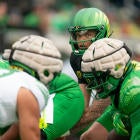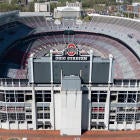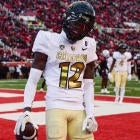Conferences are quietly preparing for the sea-changing possibility they can compensate players above current NCAA limits, significantly altering the longstanding NCAA amateurism model, according to interviews and documents obtained by CBS Sports.
A judge in the ongoing Alston vs. NCAA trial will conduct a final hearing on Dec. 18 pertaining to closing arguments. She will then decide -- likely early in 2019 -- whether scholarship limits imposed by the association violate anti-trust laws.
If the plaintiffs win, there is concern among the Power Five that a Wild West culture could take hold. The last time conferences oversaw athlete compensation was 1956 before the advent of TV, rights fees, agents and riches from the NFL and NBA.
Part of the concern is that Power Five leagues flush with cash might not be able to help themselves.
"It's harder than ever to defend [the current NCAA model]," said Tim Nevius, a former NCAA enforcement officer currently in private practice in New York.
Fearing what would amount to an open marketplace, a handful of conferences have notified officials within their leagues not to discuss the case outside their conferences for fear of collusion accusations. If conferences shared information on how to compensate athletes, that in itself could be interpreted as a way to cap scholarship benefits. That fear of collusion is based in part on rival league administrators even speaking casually about the outcome of the case.
Example: If the plaintiffs win, as expected, the SEC could theoretically compensate athletes with cars. Meanwhile, another league could offer … better cars or apartments or …
While that's an extreme example, it cuts to the heart of that Wild West scenario. The NCAA has long defended its amateurism model that limits scholarships to room, books, board, tuition and a cost of attendance stipend. The plaintiffs argue that artificially caps the true value of a scholarship.
The stakes are laid out in a memo obtained by CBS Sports from the Sun Belt Conference's general counsel to commissioner Karl Benson.
"… it is important to avoid making public statements or participating in interviews where you could be commenting on amateurism, how amateurism may have changed over time [and] the types of relief and injunction requested by plaintiffs," the memo reads.
The memo concluded: "You also may find that other commissioners are reluctant to speak about their conferences will do if the final decision someday is that each conference will set its own grant-in-aid rules."
Sources indicate that similar concerns have been shared with administrators in the SEC and other conferences. CBS Sports approached several commissioners for reactions; their responses reflect the sensitive nature of the case.
Big Ten commissioner Jim Delany was coy when asked if there had been any discussion within his conference for a day when conferences are free to compensate players above current limits.
"Any discussion?" Delany responded. He did not elaborate.
Delany once said his conference would drop down to Division III before giving up on the current collegiate model.
"After the [Alston] decision, I may have some comments. Not in advance," he added.
Big 12 commissioner Bob Bowlsby: "I don't have any expectation on it at all. I don't know what it will entail. … I'm not going to hypothesize on it. It's before the court. We're going to have to wait how it turns out."
Privately, though, there seems to be a general a feeling the plaintiffs will win, setting off alarms with which the NCAA is familiar. Alston is not the first legal challenge to the NCAA's hide-bound amateurism model. But the cumulative effect of all those court cases may be a chipping away of the NCAA's DNA. Without that one-of-a-kind amateurism model that exists nowhere else in the world, critics have wondered whether the NCAA would have any remaining worth.
Reacting to an Alston win, conferences at least have to consider what sort of compensation they would offer. That's what makes Alston unique. Those plaintiffs have found their best chances of winning are to endorse a model that leaves compensation up to the conferences.
In significant issues like this, conferences don't agree on much of anything.
In court documents, the NCAA basically confirmed what Notre Dame athletic director Jack Swarbrick suggested to CBS Sports in October. The NCAA inferred that conference autonomy in Alston would lead to a "fracturing of the existing … conferences."
Swarbrick said with conferences free to name their price, conference realignment could hinge on the compensation philosophies of those leagues. Once again, theoretically, if the SEC offered cars, how would that impact recruiting? What sort of "arms race" would that touch off with other conferences?
If the plaintiffs prevail, the NCAA is more than likely to mount a vigorous appeal process. That's what happened in O'Bannon vs. NCAA in 2014. The court ruled that the NCAA's control of an athlete's name, image and likeness were an illegal restraint of trade. On appeal, judge Claudia Wilken's ruling that $5,000 per year be put in a trust for each qualifying athlete was struck down.
The U.S. Supreme Court refused the NCAA's request to hear the case. There's little doubt the NCAA would appeal a unfavorable verdict all the way to the land's highest court once again. But that doesn't mean the Supreme Court would hear that case either.
Wilken is overseeing the Alston case as well.
"I think the plaintiffs are going to win," Nevius said.
Asked about the Alston case, NCAA president Mark Emmert said, "It's a complex legal case. We've been making our legal arguments. I like our legal arguments. It will be in the hand of the judge and then we'll wait and see what the outcome is. I have some level of confidence that no matter what the outcome, both sides are going to appeal the case so this is going to take a while."
One thing is for sure: The lawsuits will keep on coming. Shawne Alston is a former West Virginia football player who filed suit in the Northern District of California in 2014. He claimed the NCAA and Power Five conferences conspired to fix the value of a full scholarship.
That came in the same court where O'Bannon vs. NCAA was heard. That preceded White vs. NCAA in 2006. In that case, the plaintiffs similarly argued the difference between the actual cost of attendance and the NCAA caps on scholarships was an anti-trust violation. The NCAA settled for $120 million that was distributed to a class of athletes from 2002-08.
In 2015, the NCAA settled a portion of the Alston complaint for $208 million. That affected athletes who did not get the cost-of-attendance stipend from 2009-17. The average amount received by those former athletes is $6,700.
"It's not even the seven-year locust' it's the every-year locust," Tom McMillen said of the court challenges. "You're going to have litigation."
McMillen is president of Lead1 Association, the organization that represents FBS athletic directors.
The Alston plaintiffs have gone to great lengths to argue increased player compensation would not impact consumer demand. In fact, since cost of attendance was implemented in 2015, graduation rates have rose at the same time athletes are making more money just for being … athletes. Cost of attendance stipends generally average $5,000-$7,000 per player.
The plaintiffs changed their tack in Alston, arguing that compensation should be an option decided by the conferences. One expert testified it is "a fundamental economic truth … that each conference is a distinct sports league …"
Because of what amounts to those athletic fiefdoms, sometimes it's hard to get conferences to agree on much. For 50 years, 1906-56, the NCAA allowed conferences to determine compensation. Then it got complicated. The NCAA established an enforcement division. Television became more intrusive, eventually funding the conferences and the NCAA itself with its rights fees.
If conferences took over, they would most likely have to establish their own enforcement staffs. At that point, the question would have to be asked: Why is there an NCAA at all?
The plaintiffs argue that benefits over and above tuition have been paid for years without a negative impact on athletes or the amateur model. Most recently, $4,000 is available to each family of a Final Four participant to travel to the games. Bowl gifts (capped at $550 per player) seemingly are a reward for playing football.
While at Arkansas, former coach Bret Bielema once told CBS Sports that Razorbacks athletes could capitalize on such allowable benefits totaling almost $100,000 over a four-year period.
In its closing brief, the NCAA said six witnesses testified that consumers value amateurism. Yes, but exactly is amateurism? Historically, it has been a moving target that satisfies the NCAA's needs at the time. Five years ago, that current cost of attendance -- paying athletes to supplement their scholarship -- would have been a violation. Now, it's a bedrock to student-athlete welfare.
Those who believe paying players would cut into fans' interest should look around. The players are already are paid directly and indirectly in many instances. The NCAA allows schools to pay insurance premiums for high draft picks in football that can reach $80,000.
The NCAA has argued that "pay for GPA" – grade point average incentives conferences could adopt -- would establish "perverse incentives" forcing athletes to take easier classes. It should be noted that coaches regularly get contract bonuses for reaching a benchmark team GPAs. Also, in many instances, players already are encouraged to take classes that don't interfere with their sport.
But those are mere talking points for now.
"The worse thing you can do it prejudge a judge and the decision they're about to make," Delany said. "I really appreciate the arguments that have been made on our behalf. The judge will make her decision, and we'll respect that. This is a country of the rule of law."












